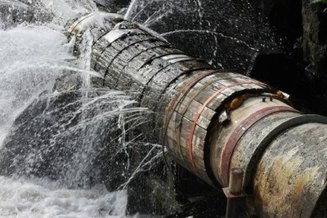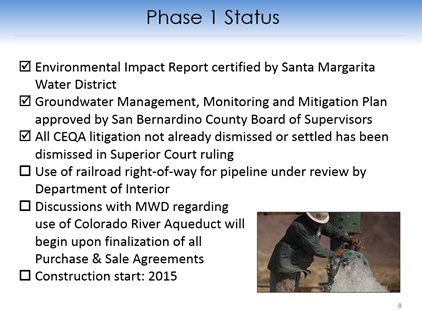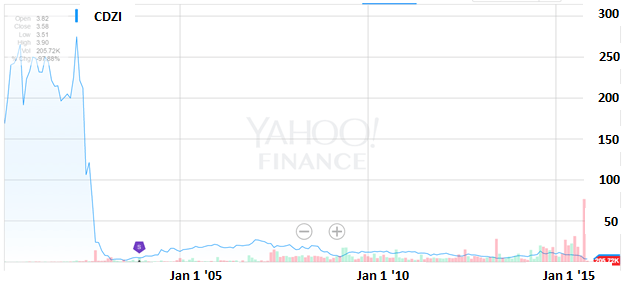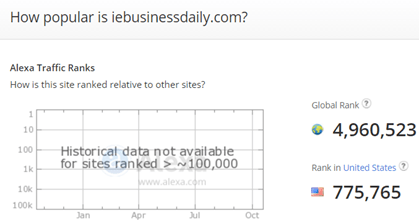 Even if you don’t agree with our conclusion on Cadiz Inc. (NASDAQ:CDZI) — a conclusion that states that CDZI’s sole project is extremely unlikely to materialize (which we will reiterate with new MWD commentary) — the capital that the company would have to raise in order to complete this project would likely be in the hundreds of millions of dollars — a sum that we think would be near impossible to raise without issuing tons of equity, especially given the company’s current balance sheet. In our opinion, Cadiz is just a terrible stock to own, with or without eventual success of its water project. Based on MWD’s comments made just days ago, we look to move the ball further on our case that CDZI’s equity is worthless.
Even if you don’t agree with our conclusion on Cadiz Inc. (NASDAQ:CDZI) — a conclusion that states that CDZI’s sole project is extremely unlikely to materialize (which we will reiterate with new MWD commentary) — the capital that the company would have to raise in order to complete this project would likely be in the hundreds of millions of dollars — a sum that we think would be near impossible to raise without issuing tons of equity, especially given the company’s current balance sheet. In our opinion, Cadiz is just a terrible stock to own, with or without eventual success of its water project. Based on MWD’s comments made just days ago, we look to move the ball further on our case that CDZI’s equity is worthless.
- We continue to stand by our analysis that the equity in CDZI Is 100% worthless
- The company was recently denied a railroad right of way usage exemption by the Department of the Interior Bureau of Land Management to use Federal land to build its water pipeline
- The project now appears to be subject to a Federal review, which we believe has almost zero chance of receiving approval. In the interim, CDZI is burning cash with major debt due early 2016.
- Even if approved, the company would have to appease the Metropolitan Water District of Southern California, which owns the Colorado River Aqueduct and which seems to have “bankruptcy” concerns and a very strong distaste for all things Cadiz
- A Metropolitan Water Department of Southern California Meeting on October 13, 2015 confirmed the MWD was “not pursing any negotiations or conversations at all”
Select MWD Comments Since Our Last Report
Metropolitan Water Department of Southern California Director: “…I hope we’re not making any representations that we’re going to help [Cadiz] try to push the project forward…”
Metropolitan Water Department of Southern California General Counsel: “…we are not pursuing any negotiations or conversations at all.”
- Metropolitan Water Department of Southern California Legal and Claims Committee Meeting, 10/13/15, (37:00)
Our Initial Call: 100% Downside
A couple of weeks ago, we wrote an article describing in detail why we think Cadiz’s equity is worth $0. Cadiz is a cash burning entity that relies on financing to fund its operations. The company has a negative tangible book value and the current CEO appears to be enriching himself and his law firm by way of CDZI’s common shareholders. Five key points of our initial article were:
- A letter on October 5th from the California State Office of the Bureau of Land Management continues to paint a bleak picture for CDZI’s focus — its ongoing “water project”.
- This reconciles with, and further validates, past critical articles suggesting that the project is doomed for eventual failure and, as such, the company may be as well.
- On top of its main business operation looking like an impossibility, CDZI faces a major liquidity crisis and has enormous debt coming due
- As it stands, CDZI’s balance sheet is insolvent and the company’s equity is worth $0 dollars on paper, with seemingly no future road toward profitability or cash generation.
- Without steady profits, we value CDZI at what it’s worth on paper and believe it’s is on its way to $0, be it from bankruptcy, eventual dilution or other means.
We concluded our article by stating that the recent opinion of the Bureau of Land Management forecasts a very dubious, if not outright impossible, future for CDZI’s solo project – a project that it has been unable to get off the ground for the last 15 years. Today, we are going to present brand-new information from an October 13 meeting of the Metropolitan Water District of Southern California that seems to finalize that CDZI’s project is not going to be moving forward in any meaningful capacity at any time soon.
We think that the comments presented herein clearly validate our opinion that CDZI, as an investment, is 100% worthless.
MWD: 13 Years of Worrying Cadiz Will Go Bankrupt
The Metropolitan Water District of Southern California (“MWD”) plays a crucial role in the future of CDZI’s sole hope for its business. The Metropolitan Water District owns and operates the Colorado River Aqueduct (“CRA”), which is a key component of CDZI’s proposed plan.
From MWD’s website,
To supply the more than 300 cities and unincorporated areas in Southern California with reliable and safe water, Metropolitan owns and operates an extensive water system including: the Colorado River Aqueduct, 16 hydroelectric facilities, nine reservoirs, 819 miles of large-scale pipes and five water treatment plants. Four of these treatment plants are among the 10 largest plants in the world. In fact, Metropolitan is the largest distributor of treated drinking water in the United States. The District imports water from the Feather River in Northern California and the Colorado River to supplement local supplies. It also helps its member agencies develop water recycling, storage and other local resource programs to provide additional supplies and conservation programs to reduce regional demands.
In other words, the MWD, like the Federal government whose land CDZI is proposing to use, must be on board for this project to even think about moving forward as it has been presented in the past.
Consult this handy checklist provided by CDZI in an October 2014 PowerPoint:

As you can see, this checklist as it would stand today would look identical to the one published by the company in 2014 — of course, with the exception of needing to push the “Construction Start” phase back some years — or maybe even eliminating it altogether from the list. As this slide shows, the company still needs:
- BLM/ROW approval (recently denied)
- Finalizations of all purchase and sale agreements of water (which may take months, if not years, to draft and implement — and only if step 1 is finally approved/circumvented)
- Discussions with the MWD regarding use of the aqueduct (which we’ll show may be a disaster in and of itself – and only if steps 1 and 2 are completed)
- Construction start (again, will require major financing and steps 1, 2, and 3 to be completed)
Don’t forget, this is all just to complete “Phase 1”.
In our last article, we showed that the company is still stuck on Step 1. In this article, we’re going to show why it’s likely that yet another brick wall has been put up at Step 3 — which we don’t believe CDZI will even get to. Lest we forget, this all is going to require a monstrous sum of cash and financing to take care of — which the company currently does not have.
Only then, of course, would we move onto “Phase 2” — another portion of the project that looks great on a PowerPoint slide, but that is going to require exorbitant sums of financing to implement in reality:

So, we continue to believe CDZI’s water project, as a whole, is 100% DOA as it stands.
We learned from the Bureau of Land Management’s recent letter to the company that a full Federal review of the project may be forthcoming and that in the past, CDZI’s science has not seen eye to eye with government science. You can read more about that in our above linked article.
Assuming they somehow miraculously get past the BLM roadblock in the project, CDZI is then going to have the MWD to deal with. Judging by the MWD’s October 13, 2015 meeting minutes, they are less than amused with CDZI and in their own words, “are not pursing any negotiations or conversations [with Cadiz] at all.”
The MWD’s October 13, 2015 Legal and Claims Committee meeting with its Board of Directors, available to stream and listen to at this link, paints an extremely bleak picture of Cadiz’s future working with the MWD. Starting at 9 minutes, the MWD general counsel begins to review and report on the department’s now closed litigation with Cadiz.
MWD’s extremely rocky relationship with Cadiz is evident as MWD’s counsel lays out the key points of its relationship that you can follow and listen to in streaming audio. We’ve denoted the timestamp of these points:
- The MWD’s initial concerns with working with CDZI in 2002 were based around CDZI not being able to finance the project (22:00)
- This supplemented a “growing number of reasons the project might fail” (23:10)
- The initial concerns that led to MWD taking a board vote in 2002 that ultimately voted to “stop the project in its entirety” (24:40).
- Cadiz sued MWD in 2005, costing the MWD $3.1 million and 3 ½ years of legal resources. MWD ultimately won on five legal causes of action and Cadiz “walked away” and dismissed the suit with prejudice after bearing its own costs, while the last claim was pending (5 contract claims, 1 claim of breach of fiduciary duty) (26:00).
- This resulted in the MWD having a final determination of not owing Cadiz any duty to pursue the project that they had proposed to MWD — in the future (29:00)
- He concludes by saying, “Where we are today, as a result, we don’t owe Cadiz any duty.” (29:40)
MWD: “We are not pursing any negotiations or conversations at all.”
After this report of the facts, MWD counsel turns to the Directors for questions and answers. Several directors, including Director Dick, sounding somewhat disgusted, ask questions in order to make sure that MWD has no obligation to work with Cadiz in the future. The directors, sounding a little annoyed that Cadiz has put the MWD through such painful litigation processes in the past, don’t seem amused by this tremendous waste of legal resources.
In response to a question about the viability of the project at (33:30), MWD’s counsel replies:
“There is a lot of skepticism on behalf of Federal Government Agencies. The US geological survey had done some research back when we were considering the project and they were concerned that the recharge through the basin under the Cadiz property may be as little as 5,000 acre feet a year…”
Obviously, this doesn’t bode well for an upcoming Federal review, if that’s what the next step is for the company.
Director Dick, at 34:30, comments that the company has been very persistent in its lobbying of the MWD for it to approve Cadiz’s project requests. He then states that he, and his colleagues, want CDZI to pay a $5M fee up front if they are ever to try and approach MWD again on this project. This would offset the legal costs that CDZI has forced onto MWD through the 3 ½ years of litigation it put the MWD through. This “application fee” also happens to represent about half of the $10.6 million that Cadiz has in the bank — and this is seemingly just a fee to captivate the MWD to consider the project again, with no guarantee of approval or any help.
Needless to say, the Directors do not sound amused by the runaround that CDZI has put them through.
They are right that CDZI has been lobbying non-stop. This language was included in an August 2015 press release, touting support from Southern California Local Elected Officials issued by Cadiz,
In a separate letter to MWD, Orange County Supervisor Lisa Bartlett also stated:
“After extensive review and outreach, I am pleased to learn that MWD and Cadiz Inc. are working collaboratively to ensure conformity to necessary water quality and operational standards. While ensuring reliable and safe drinking water, I encourage the Board and staff to do everything they can within MWD’s administrative procedures to expedite the delivery of Cadiz water to Southern California.”
Additionally, letters like this one, published in August of 2015, continue to prod the MWD for support of Cadiz’s project. As we’ll show, however, CDZI doesn’t seem to be working with the MWD — collaboratively, or at all.
At 37:00 another director asks about the hurdles the company is going through with trying to push its project forward. He comments that it’s a “fairly speculative” project with respect to its ability to deliver water. He then asks about the nature of the proposal that CDZI is currently delivering and states that he
“hope[s] we’re not making any representations that we’re going to help try to them push the project forward.”
To which MWD’s counsel responds,
“…we are not pursing any negotiations or conversations at all.” (39:25).
We think it’s obvious that the MWD may be extremely hesitant to work with CDZI in the future.
Going back as far as 2002, as laid out above, the MWD had abandoned working with Cadiz for, among other reasons, fear that the company was going to go bankrupt and potentially default on its joint obligations.
Cadiz has now spent over 13 years pushing this project, one optimistic statement at a time, while shareholders suffer major losses. In 2002, you can see what reality infringing on this optimism did to the share price.

We think another 99% loss situation is again brewing for Cadiz’s shareholders buying at today’s prices.
As a reminder, here is what CDZI was telling investors during August of this year, before having its requests denied by the Bureau of Land Management:
The proposed project has withstood numerous court challenges and is awaiting federal Bureau of Land Management approval, finalization of contracts with water companies and water transportation approvals from the Metropolitan Water District of Southern California.
Cadiz expects to clear all these hurdles this year, said Courtney Degener, a Cadiz spokesman.
CDZI’s Responses Fall Flat
In addition to the extremely damning dialogue from the October MWD meeting, the company has issued a series of responses to the BLM decision and our initial article, which we’d like to take a moment and briefly analyze.
The company announced this statement in the days following our report which concluded by saying,
“We will be persistent in our efforts to demonstrate to the BLM that the public interest and its own guidance documents require that it modify its baseless decision and if our requests are unsuccessful, we will seek a swift resolution in Federal Court. We are confident in our case and that our cause is just.”
Putting aside whether or not the company’s “cause is just,” we’d like to know how the company plans on continuing to fund the litigation it is alluding to here. Is CDZI going to launch several more multi-year lawsuits that they may eventually, again, withdraw from? Where is the funding for this going to come from and how much of the company’s representation comes directly from the law firm of which CDZI’s CEO is a shareholder of? This continued legal battle only seems to us to be benefiting one party: the law firm that the CEO is employed at and, by proxy, the CEO himself.
CDZI was also active on Twitter after our report, Tweeting out a couple of strongly worded articles and commentaries relating to the BLM’s denial of their right of way proposal. There was this commentary from “IE Business Daily,” which is a website we — and according to Alexa — no one else seems to have ever heard of.

There were also commentaries like this one, published in the San Bernadino County Sun, which called the BLM’s “recent refusal” “an embarrassment” and called for the “BLM director to “rescind the decision and hold those who made it accountable.”
A strongly worded commentary — of course, until you read the “About the Author” section at the bottom of the page:
“Larry Jensen is the former chief legal counsel to the BLM and deputy solicitor at Interior. He is currently a shareholder at Brownstein Hyatt Farber & Schreck LLP and represents Cadiz Inc.”
People at the company think the BLM made the wrong decision; what else is new?
On the 16th of October, the company issued yet another update. This helped perk the stock up momentarily, but its key points didn’t move the company’s argument forward. Here is a copy of the release, which leaves shareholders with this conclusion of its key points of options moving forward:
These various options have different time horizons.
We believe if we are to secure a near-term reversal of the determination we will be in a position to construct the pipeline in 2016. If we must pursue a legal remedy or additional environmental review, then pipeline construction could be delayed. [Geo: further than 2016].
In this scenario we would plan to continue to build the wellfield and utilize it for agricultural development until the pipeline is permitted and constructed.
As we carry out the best strategy to implement the Project in the most expeditious manner, we continue to be in good financial standing. We are in compliance with all debt covenants and have no payments due until March 2016. We also have cash on hand to implement the business strategy. We are confident we can refinance and extend our debt covenants prior to their due date if necessary.
Articles from slightly more reputable sources, like the LA Times, took another tone – like this:

The LA Times also said inconvenient things, like this:
“[the scheme had] a sort of shimmering authenticity, like a desert mirage,”
And this:
“Cadiz was the brainchild of an investment promoter named Keith Brackpool, who came to the U.S. after pleading guilty to criminal charges relating to securities trading in Britain.”
Who Will Put an End to This Insanity?
In truth, we cannot definitively say that the MWD is not going to be working with CDZI at all in the future — but what we can say is that it’s going to be up to the same Board of Directors that seem genuinely concerned about the nature of this project and the millions CDZI has cost the MWD. Ultimately it’s going to come down to their vote, so there’s technically a chance that the project could be developed –eventually.
Dealing with the cash constraints and company issues until such time is an enormous problem in and of itself. Finally, common sense says to us that the Board doesn’t seem interested in helping Cadiz at all.
In many of the company’s responses, they seem to continue to point to litigation as a potential solution for their problems. Despite not being successful in the past trying to litigate agencies like the MWD, the company continues to turn to this route as an explanation of how it is going to further its operation.
This, similar to implementing the project itself, is a very costly venture that the company is likely not going to be able to fund with just the $10.6 million that it has in the bank currently. Another point worth noting about using litigation as a solution moving forward is that, as we showed in our first article, this just seems to be another way to enrich CDZI’s law firm — a firm that CDZI’s CEO is a shareholder of andworks for.
The only meaningful cash the company can generate comes from outside financing. The company has spent its cash on administrative expenses and continued handsome salaries of its insiders. Who is going to give up and call it quits first: the company’s creditors, the company’s Board, or the company’s shareholders?
Or, perhaps regulators may be growing tired of watching this farce unfold?
The only conclusion that we can draw from ascertaining this updated outlook from the MWD is that CDZI now has yet another brick wall ahead of it in the extremely long, arduous and improbable road that it must go down in order to implement its sole business project. Trying to handicap the likelihood of CDZI ever becoming a cash generating business is extremely difficult. Anyway that you look at it, there appears to be a significant chance that CDZI is going to wind up in bankruptcy or massively diluting its shareholders. At some point, we hope that the company’s Board of Directors and the regulators begin to look at the situation realistically and ask what the best path is not only for CDZI’s common shareholders, but for the company’s creditors.
If not anything else, we have to give the company credit for perpetuating the story and the perceived possibility of this project for well over 13 years. The sordid reality, however, is that some shareholders have suffered massive losses – and those buying today may face the same fate.